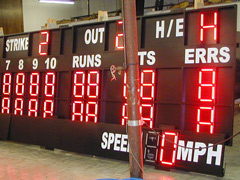Electronic Scoreboards: From Just the Score to a Full Fan Experience

Stadium scoreboards have made a migration from a simple hand controlled device to display the team scores, to the enticing and exciting electronic versions of today that entice the fan to the full venue experience. While many attendees take these devices as an accepted visual and sound production of today, the evolution of the scoreboard has skyrocketed to a must-have at every venue and manufacturers race to keep up with the hungry demand of the fans.
The manual scoreboard of years ago was little more than a changeable flip board to display the scores. Anyone that attended a local high school game or semi-pro game would always see someone manually changing the board. In many cases, the scorekeeper would lean out of a portal for the number changes. Fenway Park in Boston put their scoreboard on the level of the ground where the score changer would club up a ladder and make the score changes. The purpose was clear; it was just to keep the fans up-to-date on who was winning. Some manual boards were used for permanent sponsorship advertising, but this was costly.
With the introduction of the electronic score board, an entire new mentality arose. Two different types of electronic scoreboards were designed: one for inside games and one for games that were held outdoors… Each type of board had a specific design need. Original CRT (cathode ray tube) scoreboards were expensive, did not have good visual quality and not the best of technology. The LED electronics also added a new revenue maker: easy advertising and sponsorship. Manufacturers began talking to the individual sports stadiums regarding the venue needs. Customized specs were drawn up and custom software designed to offer a more personal experience for the fan. Crisp and sharp displays began to show replays as well as ads. Larger color screens were included in the bigger stadiums and the fan began to view the scoreboard as part of the game experience.
The cost of the bigger and flashier electronic scoreboards began to pay for itself with greater interest in sponsorship. The bigger scoreboards allowed for a larger percentage of the board to be devoted to the advertisers. As high resolution and video formats were included, the fans became more enthralled with the view. Animations, ads, replays, and personal team member stats brought the scoreboard even closer to the fan. Stadiums recognized the value of the interactive abilities of the electronic scoreboard and added high quality sound.
The latest high tech electronic scoreboards are bigger, flashier and offer high resolution visuals and sound for a full experience. The manufacturers know they have to compete with the available high tech, in-home televisions and theatres and they have turned the next generations of scoreboards into a dynamic and interactive experience for fans of all types.
One may wonder what an icon like Babe Ruth would think, if he attended one of the games of today. Which would he be watching more: the game or the entertainment on the scoreboard?
Sources:
sportvenueconstruction.com/products/scoreboards/
signindustry.com/led/articles/2003-04-29-LB-LED-Scoreboards.php3


